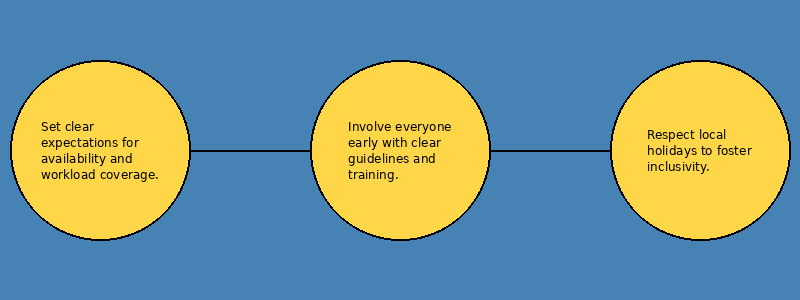Remote workers are just as crucial as those in the office, yet surprisingly, about one-third of U.S. employees don’t get paid time off. This often depends on their job role, but really, every remote team should have a solid time off policy—no exceptions.
Why? Because having a paid time off policy does wonders. It keeps the team happy, makes sure good employees stick around, and even pumps up productivity. So, setting up the right time off policy is your first big step.
This article will help you craft a leave policy that ticks the right boxes for your remote team and your company. Let’s begin by understanding the need for an optimized time off policy in remote work environments.

Why Remote Workers Need a Special Time Off Policy
Remote employees need PTO, but their policy may have to be different compared to their in-office counterparts. For one, the environment alone is vastly distinct. Remote work has challenges that can hinder tasks, such as a fluctuating Internet connection and other domestic responsibilities. Therefore, as a business owner or HR manager, you’ll need to craft a special time off policy that caters to their unique situation, including provisions for personal days. This allows employees to manage unforeseen personal obligations alongside their professional duties effectively.
To start, it helps to have a user-friendly PTO tracking tool. With it, your remote team can easily apply for time off requests in one streamlined platform. It also benefits you by allowing you to manage their annual leave requests minus the paperwork; you can track how many leaves were made and identify the employees who haven’t requested time off yet, encouraging them to take a break sometimes.
Implementing a clear and fair PTO policy also allows your remote employees to manage their time off requests more effectively, ensuring they get the much-needed rest and time for other responsibilities.
As a result, you may notice positives like:
- Reduced stress and better well-being
- Happier and more productive teams
- Less turnover, more loyalty
- Culture of trust and empowerment
These benefits extend not only to your team but also to the company as a whole, as having a clear leave policy prevents confusion and possible disputes about time off.
Key Components of an Effective Remote Time Off Policy

When crafting a time off policy for remote teams, there are several factors to consider that ensure the policy is beneficial and functional for both your company and team. These components are crucial for balancing work demands with employee well-being, making the policy practical and valuable. Here are the main components to focus on:
1. Setting Expectations and Clear Communication
Remote work thrives on clear communication.
Clear guidelines on how to request time off and what is expected before, during, and after a leave are essential. This includes setting out how far in advance notices need to be given and how handovers should be handled. Clear communication prevents misunderstandings and ensures continuity of work, particularly in teams spread across different time zones.
So, set clear expectations around availability during time off and how workloads will be covered. Regardless of your approach, know when to set limits and encourage open dialogue to ensure everyone understands and embraces the policy and avoid confusion and conflicts.
2. Rolling Out Your Time Off Policy
Get everyone on board by involving leaders and employees from the get-go. After all, it takes a supportive team dynamic to promote an effective PTO policy.
Start by rolling out the new flexible time off policy with a clear explanation of its benefits and expectations. Then, create detailed communication materials explaining the policy’s rationale, guidelines, and expectations. Make the documents readily available and use company-wide announcements along with Q&A sessions to ensure the whole team is on the same page. During the transition, it also helps to open communication channels where team members can reach out with their questions, feedback or concerns about PTO policies.
Don’t forget to equip your team with proper training, too. When using digital time off tracking tools, for instance; a quick briefing on how to use the tool will ensure a smoother rollout and maximize its efficiency for everyone.
3. Taking Note of Public Holidays & Offer Flexibility
You probably have workers from a different state or country, so take into account their local holidays as well and allow employees to take time off that suits their life commitments and work style.
For example, at DistantJob, we accommodate this by setting up our Google Calendar to include the public holidays from each team member’s country, ensuring everyone’s local holidays are recognized and respected.
Doing so can be a great way to foster inclusivity and build a strong team culture. Letting them take leave on those days can also help counter the motivation killers plaguing remote teams.
What Makes a Time Off Policy Remote-Friendly?
Any effective time off policy must be clear and flexible, especially for distributed teams.
A clear procedure for requesting time off
Set up a straightforward process for requesting time off, including how much notice is required. Detail the leave allocations for both paid leave and sick days and whether they can carry over unused PTO days or not. This ensures clarity and prevents confusion among team members.
Indicate the types of leaves they can request, such as:
- Sick leave
- Maternity leave or paternity leave
- Medical leave
- Vacation days
- Bereavement leave
- Parental leave
Your PTO Tracking Tool Should Be Transparent
Make it accessible to all employees; this approach ensures everyone understands their available time off and prevents misunderstandings or discrepancies. Also, when the rest of the company knows who’s unavailable on certain days, it makes it easier to plan workloads accordingly.
Regular Review and Adaptation of the Policy
To ensure that your time off policy remains relevant and effective over time, regular reviews and thoughtful adaptations are essential.
Every year, make it a point to check your time off policy. Why? Because it’s your best chance to fix any slips or gaps that pop up. It’s simple: see if what you’ve got lines up with your company’s goals and makes your team happy. Toss in some real data from usage rates, employee surveys, and feedback to really nail down how well your policy’s working and where you can make it better.
Don’t stop there—listen to your team regularly. Their feedback is gold for making a policy that really works.
Types of PTO
There are two main approaches to time off policies: traditional PTO and unlimited PTO. Here’s a breakdown of each type:
Traditional PTO Policy
Employees get a set paid time off accrual per year, meaning each person has a specific number of days they can request leave. In a traditional leave setup, the accrual rate often depends on the employee’s tenure.
A drawback of this type happens when employees have unused PTO, which can be a financial burden for some companies. That unused vacation time – excluding other types of PTO such as sick time – is typically converted to cash by the end of the year. If an employee resigns or gets laid off, they’re entitled to pay, part of which comes from their unused PTO hours. This adds up to a significant amount of money, totaling around USD$318 billion.
Unlimited PTO Policy
Unlimited PTO is often seen as an ideal perk that many employees, particularly remote developers, might dream of having. These policies usually tie in with performance expectations, allowing both remote and in-office teams the flexibility to take as much time off as they need, provided it doesn’t impact their work output. This flexibility is especially appealing to remote workers, who can balance work and personal life more seamlessly without a rigid schedule.
However, unlimited PTO also comes with challenges, such as a lack of structured time-off tracking. This means that both you and your employees must manually keep track of how much personal time has been taken, which can lead to uncertainties. Additionally, there is the psychological aspect where some employees might hesitate to take any leave to avoid seeming less committed to their roles.
The success of an unlimited PTO largely depends on the company policy and how effectively is implemented and managed. For remote developers, who often value autonomy and flexibility, clear communication and a foundation of mutual trust are crucial to ensure that the benefits of such a policy are realized without leading to confusion or unintentional stress.
Conclusion
As a business owner or HR manager, everyone in your company is essential, including your offsite team. But considering the different challenges remote team members face, crafting a tailored time off policy for them is crucial. It allows you to cater to their unique needs and foster a better company culture.
Armed with these insights, you can craft a robust and remote-friendly PTO plan. You can also incorporate digital tracking tools to streamline the time-off request process for both employees and managers. Furthermore, regularly seek feedback from team members so you can adapt to changing needs.
Remember, a well-implemented time off policy alongside a remote work policy as a whole promotes work-life balance, increases employee satisfaction, and fosters a productive remote work environment. So, empower your remote team to take the time off they deserve and watch your business thrive!




